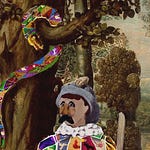VII. LA SÉRÉNADE DE PIERROT
D’un grotesque archet dissonant Agaçant sa viole plate, À la héron, sur une patte, Il pince un air inconvenant.
Soudain Cassandre, intervenant, Blâme ce nocturne acrobate, D’un grotesque archet dissonant Agaçant sa viole plate.
Pierrot la rejette, et prenant D’une poigne très délicate Le vieux par sa roide cravate, Zèbre le bedon du gênant D’un grotesque archet dissonant. VI. PIERROT’S SERENADE
Suddenly Cassandre, breaking in, condemns this night-wandering acrobat, with a grotesque dissonant bow putting his flat-faced fiddle on edge.
Pierrot throws it aside, and grabbing (in a very delicate fist) the old man by his stiff cravat, puts zebra stripes on the nuisance’s paunch with a grotesque dissonant bow.
NOTES
2 archet : In this rondel, Pierrot’s viole and bow are purely physical objects, in contrast to the trembling moon-violin and its luminous white bow in XXXII.
3 Agaçant : In DAf1718 through DAf1878 the transitive verb agacer, used literally, admitted no direct object other than dents (teeth), yet to express the literal meaning of agacer les dents English has only the figurative locution ‘to set (one’s) teeth on edge’ (e.g., Jeremiah 31:29, rendered into French in the Louvain Bible, is « Les pères ont mangé la grappe aigre, et les dents des fils en sont agacées », and as rendered into English in the King James Bible is “The fathers have eaten a sour grape, and the children’s teeth are set on edge”). DAf1935 condones one other object, nerfs (nerves): agacer les nerfs meant « ce qui cause une irritation légère dans tout l’intérieur du corps », ‘that which causes light irritation throughout the body’. Figuratively, from DAf1694 on, agacer could mean to provoke or peck at someone by words or actions; and from DAf1762 to mean—but only of a woman—« Exciter par des regards, par des manières attrayantes », ‘To excite by looks or attractive behavior’. DAf1878 extends that use, illustrating it with a new example: « Animer, exciter à prendre part à la conversation, à y mettre une certaine vivacité. Il était pensif et distrait ; on l’a agacé, il est devenu fort aimable », ‘To animate, to pull into a conversation, to encourage some liveliness, He used to be pensive and absentminded; once someone [l’a agacé], he became very friendly’. Could it be that, whatever Giraud’s Pierrot is (physically) doing to his flat-faced fiddle with his grotesque dissonant bow, the (figurative) meaning of his act is seduction (or rape) of the fiddle by the bow—or of Colombine by himself?
viole plate : Many paintings of scenes and characters from commedia dell’arte, by Watteau and others, feature plucked string instruments—guitars, mandolins, and lutes. I have found no bowed instruments played (by Pierrot or others) in such a painting until the 20th century.
4 à la héron : Aside from one instance in a 12th century illuminated Bible, and a line-drawing adapted from it (W. Bachmann, Die Anfänge des Streichinstrumentenspiels. Musikwissenschaftliche Einzeldarstellungen, Leipzig, Breitkopf & Hartel, 1964, plate 61), I have found no pictorial (or other) record of a string-player adopting this (awkward!) posture. Was it purely Giraud’s fantasy?
6 Cassandre : Another stock character in commedia dell’arte (Appendix B); see XXXVII.11 for more details. He reappears in rondels VIII, XLI, XLIII, and XLV.
7 nocturne : Nocturnal. In a non-systematic review of the G/HT French corpus, I found no non-poetic examples (and very few poetic ones) in which « nocturne » precedes the noun it modifies. The most common was nocturne courrière, an epithet for the moon. Courrière (the feminine of courrier, ‘courier’, an irregular agentive of courir, to run—the regular agentive being coureur, runner—borrowed from Italian corriere in the 14th century) is accompanied by the same usage note in DAf1694–DAf1878: « Il ne se dit guère qu’en poésie, en parlant De la lune », ‘It is hardly used except in poetry, in speaking Of the moon’. In particular, Virgil’s curru noctivago Phœbe—Phoebe [Titaness of the moon] with her night-wandering chariot [the moon itself] (Aeneid, book 10, lines 215–216)—became J. Delille’s « la nocturne courrière / Sur son char », ‘The nocturnal couriess [not named] on her chariot’ (L’Énéide traduite en vers français, vol. 4, Paris, Giguet et Michaud, 1804). If Giraud had read Delille’s Virgil in school, his idiosyncratic epithet « nocturne acrobate » for Pierrot may glancingly acknowledge the moon’s priority.
10 la rejette : As the nearest feminine noun phrase preceding the grammatical object « la » of « rejette », « sa viole plate » must be the semantic object of that verb, which is thus to be taken literally: Pierrot really is throwing aside his flat-faced fiddle. But of course he is also rejecting Cassandre’s condemnation.
13 zèbre : The noun zèbre, ‘zebra’, is rarely attested in French before the 17th century; it may derive from Latin equiferus, via Late Latin *eciferus, Old Spanish ecebro, and finally Spanish cebra or Portuguese zebra (Picoche). The adjective zebré, ‘striped like a zebra’, appears (originally applied to pelts, by natural historians) in the 1830s. DAf, starting with DAf1835, has allowed zèbré (note the e grave) as an adjective, but even now shows no sign of accepting an infinitive zèbrer of which a verb zèbré would be the regular past participle (and would, incidentally, allow Giraud’s third person singular « zèbre »). That work, however, had already been done in 1843 by Louis-Nicolas Bescherelle, who in his Dictionnaire usuel de tous les verbes français [etc.], Vol. 2, Paris, 1843, seems to have been the first lexicographer to acknowledge zèbrer. Perhaps Bescherelle (who cited no text) back-formed that infinitive to justify interpreting the existing adjective as a participle.









Share this post